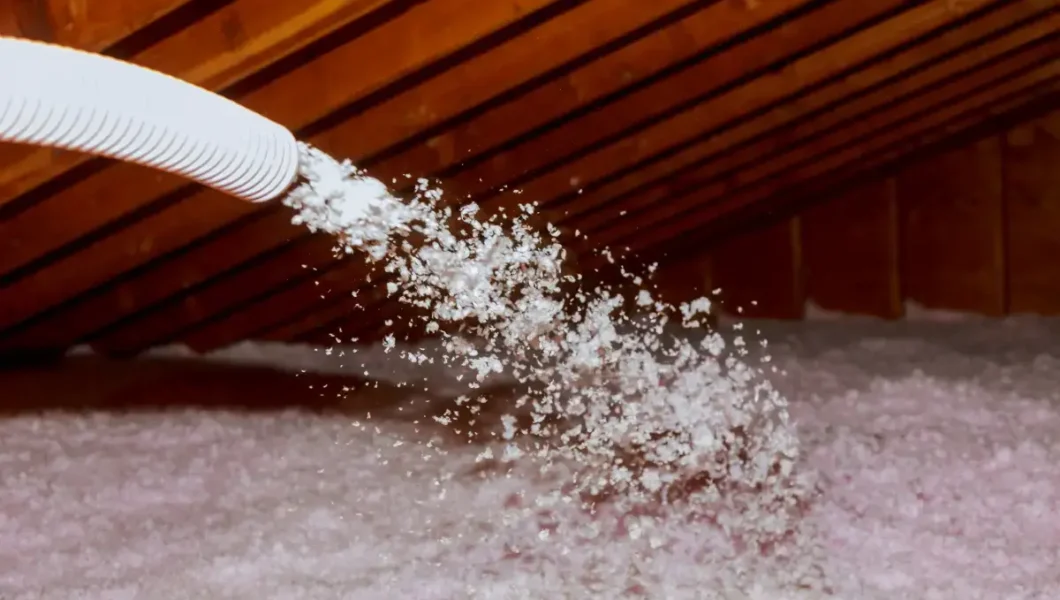When it comes to home insulation, blown-in insulation is a highly effective and versatile option that homeowners increasingly prefer. Offering excellent thermal performance, soundproofing, and energy efficiency, blown-in insulation is a great choice for both new construction and retrofitting older homes. This blog will explore what blown-in insulation is, its advantages, installation methods, and important considerations to keep in mind.
What is Blown-In Insulation?
Blown-in insulation, also known as loose-fill insulation, consists of small particles of fiber, foam, or other materials that are blown into wall cavities, attics, and floors using special equipment. The materials used can vary, but the most common types include cellulose, fiberglass, and mineral wool. The loose-fill nature of blown-in insulation allows it to fill spaces more completely and effectively than traditional batt insulation.
Benefits of Blown-In Insulation
- Energy Efficiency: Blown-in insulation provides excellent thermal performance, reducing heat transfer between the inside and outside of your home. This results in lower energy consumption for heating and cooling, translating to significant savings on utility bills.
- Improved Comfort: By maintaining a consistent indoor temperature, blown-in insulation helps create a more comfortable living environment. It reduces drafts and cold spots, ensuring that every room in your home stays cozy throughout the year.
- Soundproofing: The dense, fibrous nature of blown-in insulation makes it an effective sound barrier. It helps reduce noise from outside and between rooms, contributing to a quieter and more peaceful home.
- Eco-Friendly Options: Materials like cellulose are made from recycled paper products, making blown-in insulation an environmentally friendly choice. Opting for eco-friendly insulation materials can reduce your home’s carbon footprint and support recycling efforts.
- Fire Resistance: Blown-in insulation materials, particularly cellulose, are treated with fire-retardant chemicals to enhance their resistance to fire. This added safety feature provides peace of mind for homeowners.
Types of Blown-In Insulation
- Cellulose: Made from recycled paper products treated with borates for fire and pest resistance, cellulose insulation is a popular choice for its eco-friendliness and effectiveness.
- Fiberglass: Consisting of fine glass fibers, fiberglass insulation is non-combustible and provides good thermal performance. It’s lightweight and easy to install, making it a common choice for many homeowners.
- Mineral Wool: Made from natural rock or slag, mineral wool insulation is known for its excellent fire resistance and soundproofing properties. It’s also resistant to moisture and pests, making it a durable option.
Installation Methods
Blown-in insulation can be installed in various areas of a home, and the method used will depend on the specific application:
- Attic Insulation: Blown-in insulation is commonly used in attics to create a thick, even layer of insulation. The material is blown into the attic space using a hose, filling all gaps and voids to provide comprehensive coverage.
- Wall Insulation: For existing walls, small holes are drilled into the wall cavities, and the insulation material is blown in through these openings. This method is ideal for retrofitting older homes where adding insulation can significantly improve energy efficiency.
- Floor Insulation: Blown-in insulation can also be used to insulate floors, particularly in homes with crawl spaces or basements. The insulation material is blown into the space between floor joists to reduce heat loss and improve comfort.
Considerations and Maintenance
While blown-in insulation offers many benefits, there are some considerations to keep in mind:
- Settling: Over time, blown-in insulation can settle, reducing its effectiveness. Proper installation techniques, such as ensuring the correct density and coverage, can minimize settling. Periodic inspections may be necessary to check for any settling and add more insulation if needed.
- Moisture Control: Although some blown-in insulation materials are resistant to moisture, it’s important to ensure that your home has proper ventilation and vapor barriers. Moisture buildup can compromise the insulation’s effectiveness and lead to mold growth.
- Professional Installation: Blown-in insulation requires specialized equipment and expertise for proper installation. Hiring a professional ensures that the insulation is installed correctly and performs optimally.
- Cost: While blown-in insulation can be more expensive upfront compared to other types, the long-term savings on energy bills and the improved comfort and efficiency of your home often justify the initial investment.
Conclusion
Blown-in insulation is a versatile, efficient, and environmentally friendly option for insulating your home. Whether you’re building a new home or retrofitting an older one, blown-in insulation can provide significant benefits in terms of energy efficiency, comfort, and soundproofing. By understanding the types of materials available, the installation methods, and the considerations involved, you can make an informed decision and enjoy the long-term advantages of a well-insulated home. Investing in blown-in insulation is a smart choice that pays off in energy savings, enhanced comfort, and a quieter living environment.






